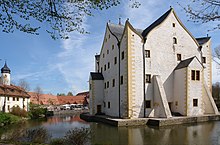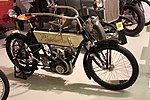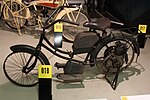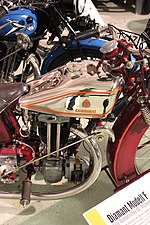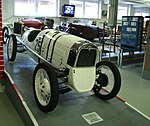Museum for Saxon Vehicles
 Logo of the vehicle museum on the house wall |
|
| Data | |
|---|---|
| place | Zwickauer Straße 77, 09112 Chemnitz ( Stern-Garagen ) |
| Art | |
| architect | Luderer & Schröder (Chemnitz) together with government builder Hans Schindler |
| opening | 1995; after moving in 2008 |
| operator |
Association Museum for Saxon Vehicles Chemnitz e. V.
|
| management |
Dirk Schmerschneider
|
| Website | |
| ISIL | DE-MUS-959813 |
The Museum for Saxon Vehicles , sometimes also referred to as the Vehicle Museum Chemnitz , is a museum for bicycles, motorcycles and automobiles in Chemnitz . The exhibition in the historic Stern-Garagen , one of the oldest preserved multi-storey car parks in Germany, with around 200 exhibits deals specifically with the history of Saxon vehicle construction.
history
prehistory
As early as the GDR era , there were numerous collectors of historic vehicles in the Chemnitz region - at that time in the Karl-Marx-Stadt district - due to the importance of the Karl-Marx-Stadt-Zwickau industrial region for German vehicle construction. The attempt to build a museum failed despite specific concepts and selected rooms because of the official approval. Brands like Auto Union were viewed as fascist armaments factories in the GDR , but portraying them in a different light met with political rejection.
Foundation of a museum association and first exhibition
After the fall of the Berlin Wall and the re-establishment of the Free State of Saxony in 1993, the Association Museum for Saxon Vehicles Chemnitz e. V. founded by the vehicle restorer and author Frieder Bach. Suitable exhibition rooms were found in the former horse stables of the Klaffenbach moated castle, which was extensively restored between 1991 and 1995 . The collectors also received significant support from the then independent municipality of Klaffenbach , which organized and acquired over 100 historical vehicles and other exhibits and made them available to the association for the exhibition. In 1995, with the completion of the moated castle, the Museum for Saxon Vehicles was also able to open. Over 120 exhibits document the history of Saxon vehicle construction on two floors with a total of around 800 m² of exhibition space. With the incorporation of Klaffenbach into Chemnitz on January 1, 1997, the exhibits became the property of the City of Chemnitz. The high-quality collection and numerous special exhibitions made the museum known beyond the borders of the region.
Due to the location of the moated castle on the Würschnitz , the museum was exposed to the risk of flooding . During the flood of the century in 2002 , the water masses penetrated the moated castle and the lower floor of the museum was up to 70 cm under water. Numerous exhibits and large parts of the facility were badly damaged. Closing the museum was even considered. In addition to cleaning and repairing the exhibits, the exhibition rooms had to be redesigned to make them flood-proof, which meant that there was no need for special exhibitions. In 2007, changed fire protection regulations required a reconstruction of the museum, which would have reduced the museum area again. However, the association refused the originally planned conversion of the premises without relocating the exhibits because of the damaging effects of the stone dust. A temporary relocation of the collection for the duration of the renovation work came into consideration, but ultimately those responsible decided on a permanent new location for the museum. The search for new exhibition spaces by the city of Chemnitz took over a year.
New location of the museum
In 2008 the company moved to the Stern garages on Zwickauer Strasse in the Chemnitz district of Kappel . The museum has around 1000 m² of exhibition space here. All vehicles were transported within 10 days, and only two months passed between the final closure in Klaffenbach and the opening in the Stern garages. The move was used to structure the exhibition from scratch. Special exhibitions are also possible again. In 2010, the Museum of Jørgen Skafte Rasmussen, the grandson was the founder of the same name of Zschopauer automotive and motorcycle brand DKW , private Rasmussen Collection consisting of 24 cars and about 30 motorcycles and stationary engines of the DKW brand offered. For reasons of space, however, this had to be rejected. Therefore, the Rasmussen collection was split up. The cars went to the neighboring Chemnitz Museum of Industry , the motorcycles are "Motorcycle in the exhibition T space" on Castle Wildeck seen in Zschopau.
Endangering the continuation of the museum
At the beginning of January 2013 it was announced that the city administration was examining the sale of exhibits from the city-owned part of the collection, which comprised 115 exhibits. In addition to small exhibits, three automobiles, 21 motorcycles and 12 bicycles should also be affected by sales. The reason for this was the termination of the loan agreement for the exhibits by the museum association. Above all, the association wanted to make it clear that "for a meaningful presentation in [...] [the vehicle museum rooms] the existence of the vehicle museum must be fundamentally secured". The museum receives annual funding from the city of Chemnitz from the area of municipal art and culture. However, increased expenses and the budget freeze of the city of Chemnitz endangered the museum's funding. Instead of increasing the funds for the museum, the city looked for an alternative location for the exhibits. The Chemnitz Industrial Museum , the Schloßberg Museum Chemnitz and the Chemnitz Art Collections were inquired about . Since none of the Chemnitz museums was able to accommodate the exhibits, an accommodation of the exhibits outside of Chemnitz and the sale were examined. The August Horch Museum in Zwickau was considered as a possible storage location for some exhibits . After massive protests by city councils and citizens, the Mayor of Chemnitz, Barbara Ludwig , turned down the sale on January 7, 2013.
Memberships
The museum is a member of the Friends of Technological History Museums in the Chemnitz Region, which includes the Chemnitz Industrial Museum, the Oelsnitz Mining Museum , the German Games Museum , the Ebersdorf School Museum , the motorcycle exhibition in Wildeck Castle in Zschopau, the Saxon Railway Museum , the Saxon Commercial Vehicle Museum in Hartmannsdorf and the Technology museum rope drainage system.
Collection / exhibition
The collection includes over 200 exhibits from more than 70 manufacturers, 150 of which are automobiles, motorcycles and bicycles (as of the end of 2014). Some of the exhibits are owned by association members, 115 exhibits belong to the city of Chemnitz. 45 percent of the exhibits are private loans, mostly on permanent loan. The collection is characterized by numerous unique items, including, for example, a motorcycle from the Seidel & Naumann brand , which could be the oldest motorcycle in Germany and has been proven to be one of the three oldest motorcycles in Germany. Several unique commercial vehicles are also part of the collection. A special feature because these are usually not retained. Most of the vehicles are in roadworthy condition. The exhibition extends over the 1000 m² of the ground floor of the Stern garages. The parking boxes in the garage are used to subdivide the exhibition chronologically; their walls are hung with partially unpublished images.
| In the area of early motorization (1885–1918) the transition from bicycle to motorcycle, from horse-drawn carriage to full-fledged automobile is shown. The origins of the bicycle can still be clearly seen in the first motorcycles, such as the Wanderer 3 HP motorcycle from 1910 or the 5.5 HP phenomenon from 1907. Automobiles such as the Polymobile from 1903 still clearly show the descent from the horse-drawn carriage. This area shows the enormous progress made during this period and is also characterized by experimental concepts such as the magnet self-drive, until the first full-fledged automobiles such as the Wanderer Puppchen were developed towards the end of the decade . | |
| The area of inflation (1918–1924) deals with financial inflation and above all the inflationary increase in the number of vehicle manufacturers and vehicle purchases. Due to the Versailles Treaty , war-capable technology was no longer allowed to be built in Germany, and former arms companies switched to vehicle production. In times of monetary devaluation, vehicles were a stable investment. Above all, vehicles from long-forgotten brands such as Heros , Hiekel , Presto , Oruk , or Harlè are shown . Models such as the Phenomobil three-wheeler with front-wheel drive from 1921 show that even during this time, variations on the basic vehicle concepts were repeatedly dared. | |
|
|
The Golden Twenties (1925–1933) section shows the development of a reliable, comfortable vehicle that offers more and more functions with less and less operator effort. At this heyday of vehicle construction in Saxony, almost a quarter of German car production came from Saxony. Above all, you can see the high-quality automobiles and motorcycles of the well-heeled citizens who conquered the cityscape at the end of the 1920s. Motorcycles from OD , Elfa and Diamant as well as automobiles from Audi and DKW are on display . |
| Under the motto War and New Beginning (1933–1948) , vehicles are presented that have been specially converted for use in war. In addition to a DKW NZ 350 Wehrmacht team , a Wanderer W 10 can also be seen, which has been converted to a wood gasifier , as petrol was only issued for journeys that were important for the war effort. | |
| Aufbruch (1948–1955) makes it clear that after the war there was hardly any new development. Instead, vehicle models from before the end of the war were used. Their further development was mostly limited to adapting the construction to the existing scarcity of raw materials. For example, the IFA F8 on display is largely identical to the DKW F8 , which was built from 1939 to 1942. Due to the lack of body panels, the bonnet and other body parts were made of thermoset, a plastic that could be made from waste products from the chemical industry and cotton that is unusable for the textile industry. An auxiliary motor for bicycles will also be shown, which could be retrofitted to any bike. | |
| The area of keeping up / helping to shape (1956–1970) stands for the innovative, progressive phase in GDR vehicle construction. It can be seen that the models in the GDR at that time were quite comparable to the vehicles in the FRG. The AWZ P70 , which was still technically based on the IFA F8, marked an intermediate stage on the way to large-scale production for mass mobilization. You can see the extremely rarely preserved station wagon variant. With the Trabant P 50 , one of the world's first fully-fledged small cars with front-wheel drive was finally developed. In order to circumvent the steel embargo of the western states, the proven material duroplastic from the F8 was used again. A positive side effect was the low vehicle weight with the associated fuel savings. | |
| Stagnation (1971–1990) makes it clear that after the innovative beginnings, the vehicle industry in the GDR was no longer competitive from the 1970s. Innovations and further developments largely fell by the wayside. Due to the shortage economy, the production backlog widened for several years. | |
| In addition to the chronological part of the exhibition, which is distributed over the historic parking boxes in the multi-storey car park, the museum also offers other areas on special topics. Part of the exhibition deals with DKW's involvement in racing and shows various racing cars and racing motorcycles. A true-to-original assembly line for DKW motorcycles with many original parts illustrates the progressiveness of the DKW brand at the time and thus also explains one of the reasons why DKW has become one of the most successful motorcycle manufacturers in Europe. The DKW assembly line was the world's first motorcycle assembly line in the 1920s. In a video presentation, the visitor can see how quickly a DKW motorcycle could be assembled on the assembly line back then. In a simulated workshop scene, you can see, among other things, an original diagnostic device from the 1930s with which all functions of the vehicle's electrical system could already be checked. A large three-level podium shows a timeline of the development from DKW to MZ . More than 20 models document the development of motorcycle construction in Zschopau up to 1990. In a separate area, cycling is highlighted. In addition to old racing bikes , the exhibits also include historical pacemakers for standing races . The collection also includes an engine collection . Numerous other motorcycles, automobiles and bicycles are exhibited in the areas between the themed areas. In the front area of the museum there is space for special exhibitions. In addition to the numerous special exhibitions, the museum also frequently organizes vehicle meetings for historic Saxon brands. |
See also
Web links
- www.fahrzeugmuseum-chemnitz.de - website of the museum
- www.oldtimerdienst-chemnitz.de - Website of the restorer, book author and association founder Frieder Bach
- Video of the new opening in a historic multi-storey car park. (No longer available online.) In: sachsen-fernsehen.de. Archived from the original on March 19, 2016 (memento defective).
Individual evidence
- ^ Frieder Bach: The history of the museum association. In: fahrzeugmuseum-chemnitz.de, accessed on July 29, 2018.
- ↑ a b c d e Dirk Schmerschneider: From the horse stable to the multi-storey car park . In: Förderverein Industriemuseum Chemnitz e. V. with the Chemnitz Industrial Museum (ed.): Museum courier of the Chemnitz Industrial Museum and its support association . 9th year, 24th edition, December 2009, 14th December 2009, ISSN 1862-8605 , p. 16–18 ( archive.org [PDF; 9.3 MB ; accessed on July 29, 2018] Memento in the Internet Archive ).
- ↑ Jürgen Schwarz: Reliable partners after the flood - Museums help museums - Saxon Museum Association supports institutions affected by the flood. In: museumspraxis.info. Retrieved July 29, 2018 (Source: Freie Presse . August 22, 2002, p. A10).
- ↑ (ULI / ER / JOE / reh): Chemnitz: The big tidying up after the flood - flood victims can leave furniture - 400 police officers help in other emergency areas. In: Freiepresse.de. Retrieved July 29, 2018 .
- ↑ A coup for the industrial museum - grandson of the DKW founder makes his vintage car collection available - the fire brigade show has to give way. In: Freiepresse.de. January 6, 2010, accessed July 29, 2018 .
- ↑ Experience industry in transition. (No longer available online.) In: saechsisches-industriemuseum.de. Archived from the original on December 5, 2014 ; accessed on July 29, 2018 (new area of the permanent exhibition in the Chemnitz Industrial Museum).
- ↑ DKW jewelry now belongs to the city - the grandson of the DKW founder gave Zschopau his motorcycle collection. In: Freiepresse.de. May 27, 2011, accessed July 29, 2018 .
- ↑ Rasmussen remains connected to Zschopau - grandson of the industrialist Jørgen Skafte Rasmussen is considering further donations. In: Freiepresse.de. October 12, 2012. Retrieved July 29, 2018 .
- ↑ motorcycle dreams. In: motorbike-dreams.com. Retrieved February 10, 2013 .
- ↑ The motorcycle city. History. In: zschopau.de. Retrieved on July 29, 2018 (also for the motorcycle exhibition).
- ↑ a b c Due to lack of space: Chemnitz town hall wants to sell museum exhibits - administration is examining the sale of rare vintage cars - city councils are outraged. In: Freiepresse.de. January 7, 2013, accessed July 29, 2018 .
- ^ Chemnitz: OB refuses to sell vintage cars. In: Freiepresse.de. January 8, 2013, accessed July 29, 2018 .
- ^ Friends of Technology History Museums, Chemnitz region. (No longer available online.) In: saechsisches-industriemuseum.de. Archived from the original on June 9, 2013 ; Retrieved February 25, 2013 .
